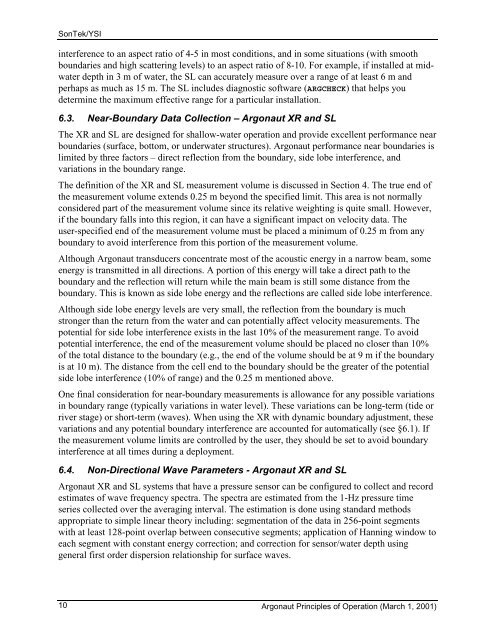SonTek/YSI Argonaut-XR Technical Manual - HydroScientific West
SonTek/YSI Argonaut-XR Technical Manual - HydroScientific West
SonTek/YSI Argonaut-XR Technical Manual - HydroScientific West
Create successful ePaper yourself
Turn your PDF publications into a flip-book with our unique Google optimized e-Paper software.
<strong>SonTek</strong>/<strong>YSI</strong><br />
interference to an aspect ratio of 4-5 in most conditions, and in some situations (with smooth<br />
boundaries and high scattering levels) to an aspect ratio of 8-10. For example, if installed at midwater<br />
depth in 3 m of water, the SL can accurately measure over a range of at least 6 m and<br />
perhaps as much as 15 m. The SL includes diagnostic software (ARGCHECK) that helps you<br />
determine the maximum effective range for a particular installation.<br />
6.3. Near-Boundary Data Collection – <strong>Argonaut</strong> <strong>XR</strong> and SL<br />
The <strong>XR</strong> and SL are designed for shallow-water operation and provide excellent performance near<br />
boundaries (surface, bottom, or underwater structures). <strong>Argonaut</strong> performance near boundaries is<br />
limited by three factors – direct reflection from the boundary, side lobe interference, and<br />
variations in the boundary range.<br />
The definition of the <strong>XR</strong> and SL measurement volume is discussed in Section 4. The true end of<br />
the measurement volume extends 0.25 m beyond the specified limit. This area is not normally<br />
considered part of the measurement volume since its relative weighting is quite small. However,<br />
if the boundary falls into this region, it can have a significant impact on velocity data. The<br />
user-specified end of the measurement volume must be placed a minimum of 0.25 m from any<br />
boundary to avoid interference from this portion of the measurement volume.<br />
Although <strong>Argonaut</strong> transducers concentrate most of the acoustic energy in a narrow beam, some<br />
energy is transmitted in all directions. A portion of this energy will take a direct path to the<br />
boundary and the reflection will return while the main beam is still some distance from the<br />
boundary. This is known as side lobe energy and the reflections are called side lobe interference.<br />
Although side lobe energy levels are very small, the reflection from the boundary is much<br />
stronger than the return from the water and can potentially affect velocity measurements. The<br />
potential for side lobe interference exists in the last 10% of the measurement range. To avoid<br />
potential interference, the end of the measurement volume should be placed no closer than 10%<br />
of the total distance to the boundary (e.g., the end of the volume should be at 9 m if the boundary<br />
is at 10 m). The distance from the cell end to the boundary should be the greater of the potential<br />
side lobe interference (10% of range) and the 0.25 m mentioned above.<br />
One final consideration for near-boundary measurements is allowance for any possible variations<br />
in boundary range (typically variations in water level). These variations can be long-term (tide or<br />
river stage) or short-term (waves). When using the <strong>XR</strong> with dynamic boundary adjustment, these<br />
variations and any potential boundary interference are accounted for automatically (see §6.1). If<br />
the measurement volume limits are controlled by the user, they should be set to avoid boundary<br />
interference at all times during a deployment.<br />
6.4. Non-Directional Wave Parameters - <strong>Argonaut</strong> <strong>XR</strong> and SL<br />
<strong>Argonaut</strong> <strong>XR</strong> and SL systems that have a pressure sensor can be configured to collect and record<br />
estimates of wave frequency spectra. The spectra are estimated from the 1-Hz pressure time<br />
series collected over the averaging interval. The estimation is done using standard methods<br />
appropriate to simple linear theory including: segmentation of the data in 256-point segments<br />
with at least 128-point overlap between consecutive segments; application of Hanning window to<br />
each segment with constant energy correction; and correction for sensor/water depth using<br />
general first order dispersion relationship for surface waves.<br />
10<br />
<strong>Argonaut</strong> Principles of Operation (March 1, 2001)


